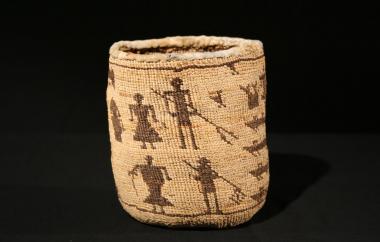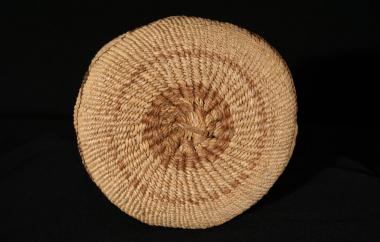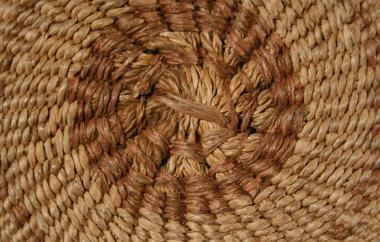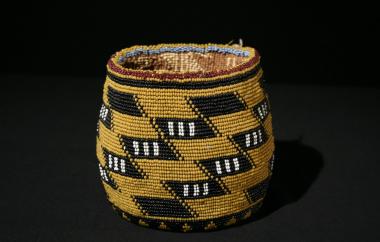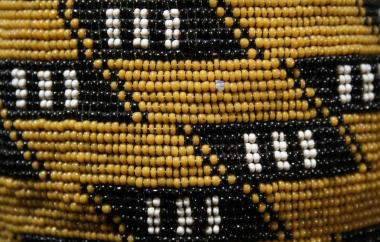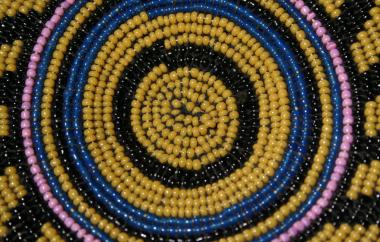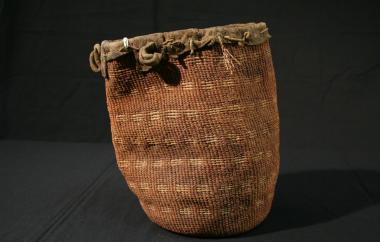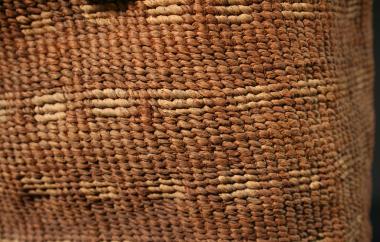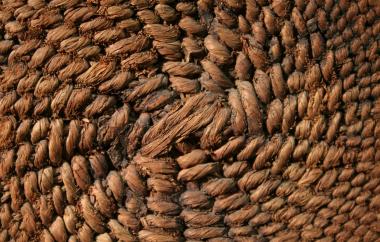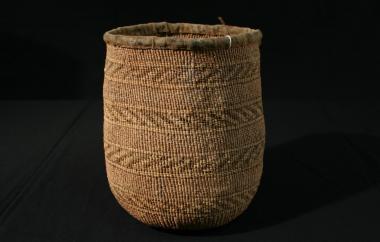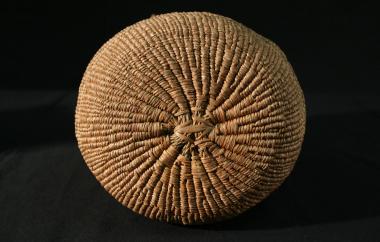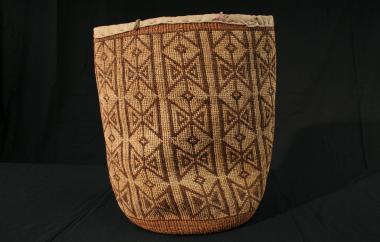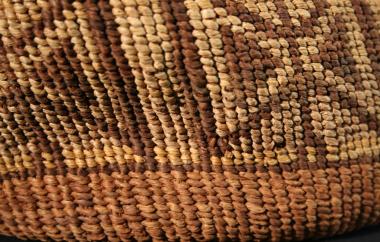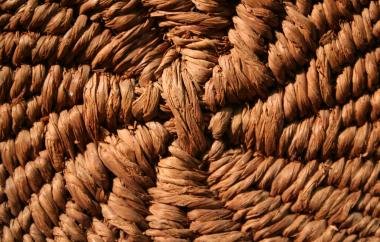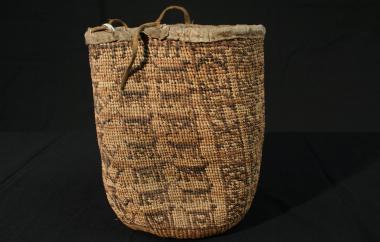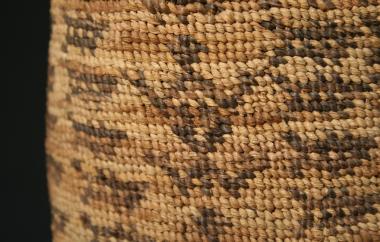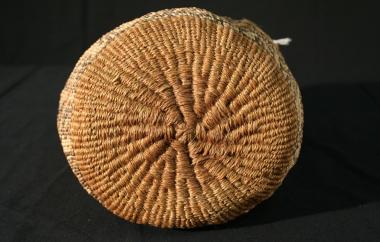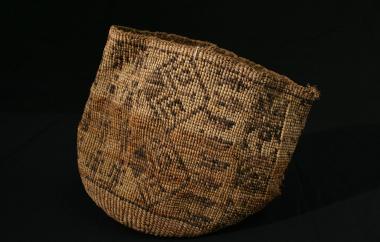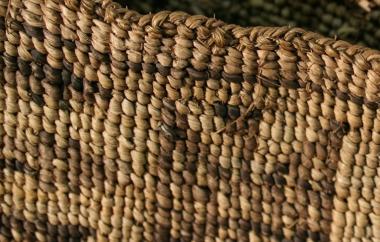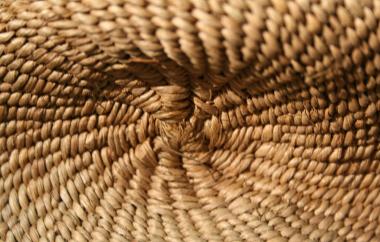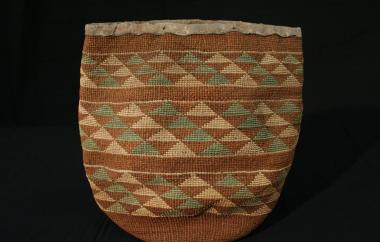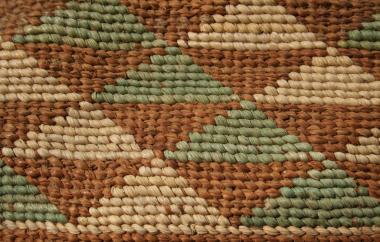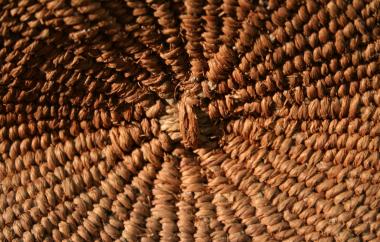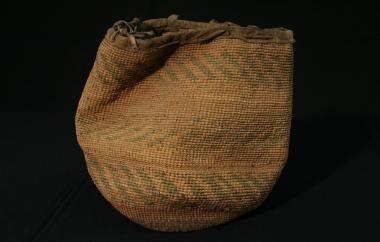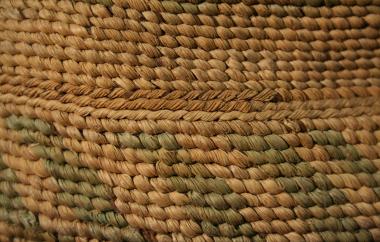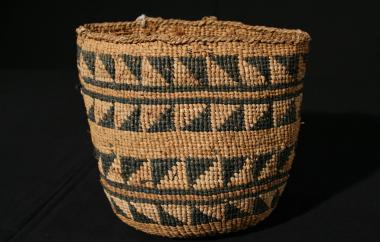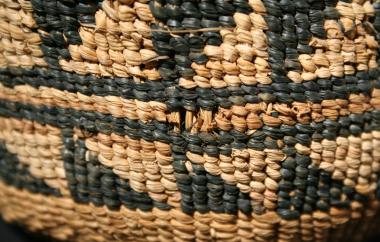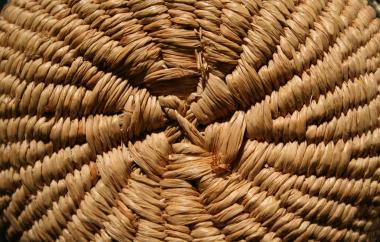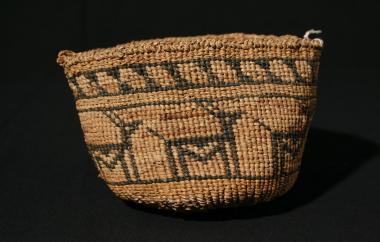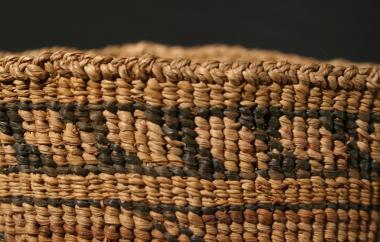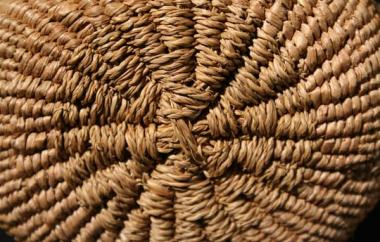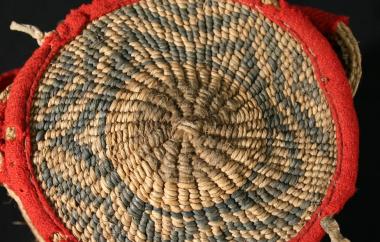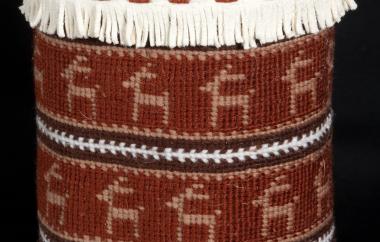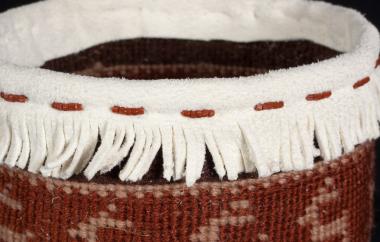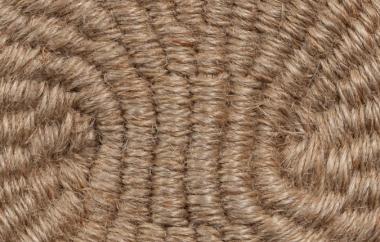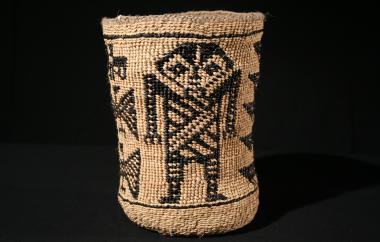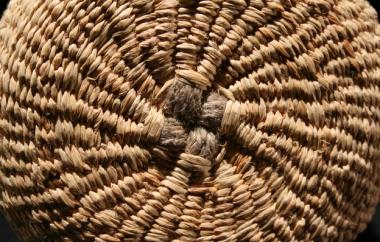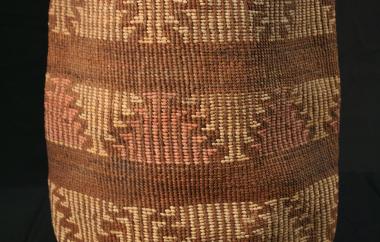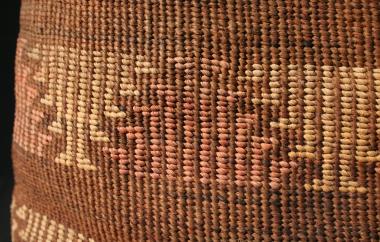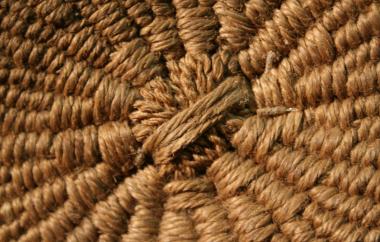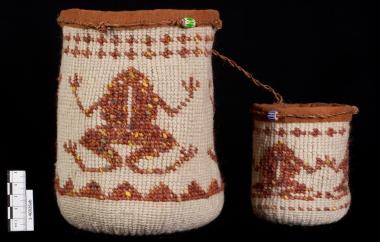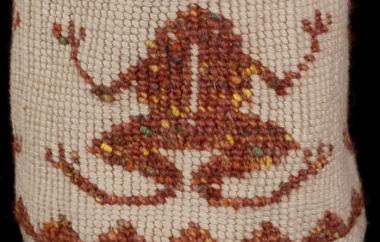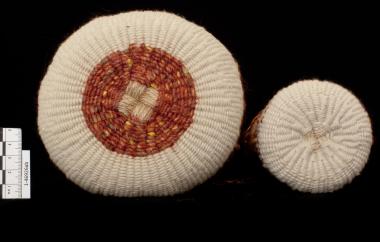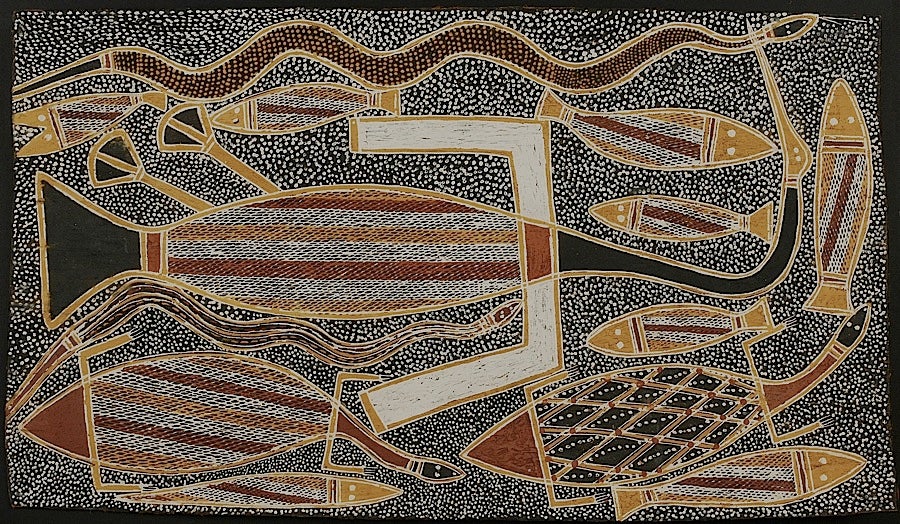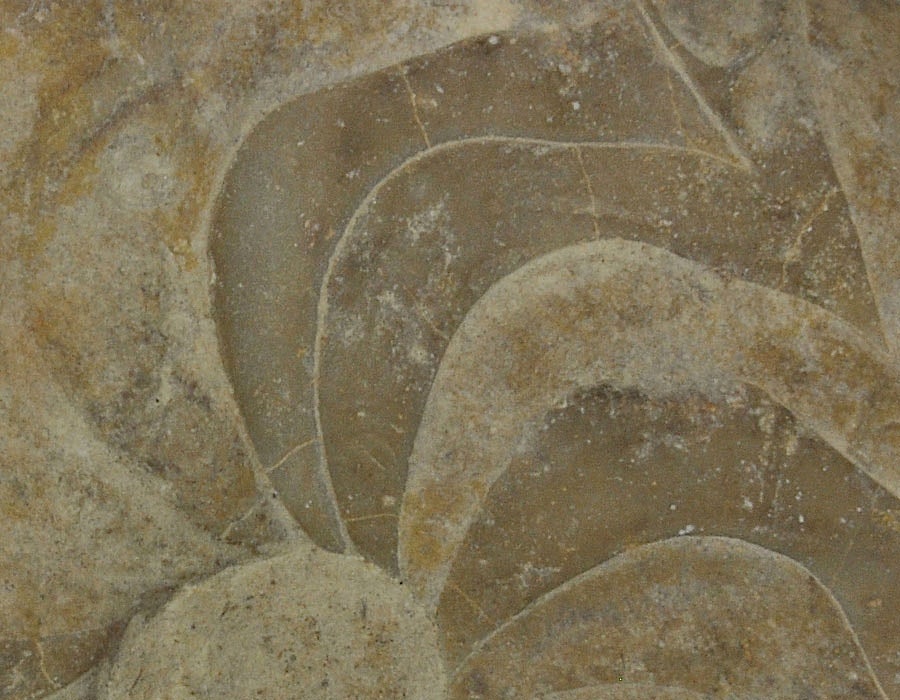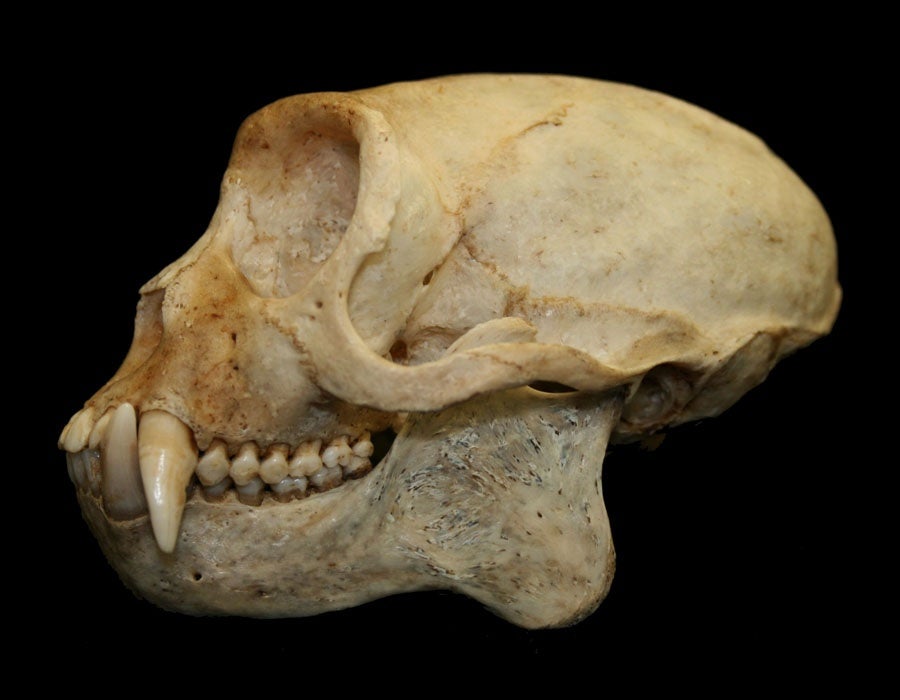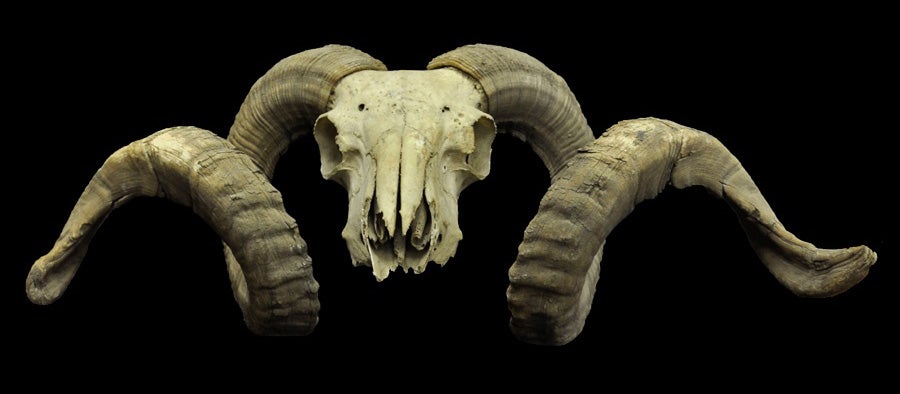Flexible cylindrical baskets, also known as 'sally bags,' are a hallmark of Columbia Plateau weaving. Historically often identified with Wasco and Wishram peoples, they were also produced by neighboring groups like Umatilla and Cayuse. Over time, traditional fibers like dogbane and grasses have been augmented with new materials, including cornhusks, yarn, and even beads. Rims are often finished with leather, with loops to attach the basket to a belt. Sally bags could thus be used to carry and store roots and other foods, as well as medicines and personal items. Contemporary weavers, including Pat Courtney Gold and Natalie Kirk, continue to create sally bags, as illustrated by examples of their work shown here.
A sample of museum holdings is presented here, many of which were photo-documented by Roger Scott as part of the museum's ongoing digitizing efforts. Details of each basket 'start' are included — while not extensively documented, the initiation of a basket may be viewed as a signature identifying a particular weaver's work.
Images © UO Museum of Natural and Cultural History. Production of this gallery received generous funding from The Ford Family Foundation.
Cat. #1-903
Cylindrical Bag, with scenes from Columbia River life (6")
Wasco
Cat. #1-903
Cylindrical Bag Detail (6")
Wasco
Cat. #1-903
Cylindrical Bag Detail
Wasco
Cat. #1-12042
Cylindrical Bag, with beaded surface (4 1/2")
Wasco-Wishram
Cat. #1-12042
Cylindrical Bag detail, with beaded surface (4 1/2")
Wasco-Wishram
Cat. #1-12042
Cylindrical Bag detail, with beaded surface (4 1/2")
Wasco-Wishram
Cat. #1-12673
Cylindrical Bag, with dashed stripes and carrying loops (9 1/2")
Umatilla
Cat. #1-12673
Cylindrical Bag detail, with dashed stripes and carrying loops (9 1/2")
Umatilla
Cat. #1-12673
Cylindrical Bag detail, with dashed stripes and carrying loops (9 1/2")
Umatilla
Cat. #1-12694
Cylindrical Bag, with horizontal stripes (7")
Cayuse
Cat. #1-12694
Cylindrical Bag detail, with horizontal stripes (7")
Cayuse
Cat. #1-12694
Cylindrical Bag detail, with horizontal stripes (7")
Cayuse
Cat. #1-12700
Cylindrical Bag, with stylized butterflies or birds (14 1/4")
Wasco
Cat. #1-12700
Cylindrical Bag detail, with stylized butterflies or birds (14 1/4")
Wasco
Cat. #1-12700
Cylindrical Bag detail, with stylized butterflies or birds (14 1/4")
Wasco
Cat. #1-12704
Cylindrical Bag, with birds, butterflies, fish and frogs (?) (7 1/2")
Cayuse
Cat. #1-12704
Cylindrical Bag detail, with birds, butterflies, fish and frogs (?) (7 1/2")
Cayuse
Cat. #1-12704
Cylindrical Bag detail, with birds, butterflies, fish and frogs (?) (7 1/2")
Cayuse
Cat. #1-15619
Cylindrical Bag, with typical diamond-shaped face (7")
Wasco
Cat. #1-15619
Cylindrical Bag detail, with typical diamond-shaped face (7")
Wasco
Cat. #1-15619
Cylindrical Bag detail, with typical diamond-shaped face (7")
Wasco
Cat. #1-15623
Cylindrical Bag, with dyed overlay (10")
Wasco
Cat. #1-15623
Cylindrical Bag detail, with dyed overlay (10")
Wasco
Cat. #1-15623
Cylindrical Bag detail, with dyed overlay (10")
Wasco
Cat. #1-15624
Cylindrical Bag, with dyed overlay and false embroidery (8")
Wasco
Cat. #1-15624
Cylindrical Bag detail, with dyed overlay and false embroidery (8")
Wasco
Cat. #1-15624
Cylindrical Bag detail, with dyed overlay and false embroidery (8")
Wasco
Cat. #2-1226
Cylindrical Bag, with died overlay (5")
Wasco-Wishram
Cat. #2-1226
Cylindrical Bag detail, with died overlay (5")
Wasco-Wishram
Cat. #2-1226
Cylindrical Bag detail
Wasco-Wishram
Cat. #2-1227
Cylindrical Bag, with deer figures (3 1/2")
Wasco-Wishram
Cat. #2-1227
Cylindrical Bag detail, with deer figures (3 1/2")
Wasco-Wishram
Cat. #2-1227
Cylindrical Bag, with deer figures (3 1/2")
Wasco-Wishram
Cat. #2-1236
Cylindrical Bag, lidded with cloth trim (9 7/8")
Wasco-Wishram
Cat. #2-1236
Cylindrical Bag lid detail, lidded with cloth trim (9 7/8")
Wasco-Wishram
Cat. #2-1236
Cylindrical Bag detail, lidded with cloth trim (9 7/8")
Wasco-Wishram
Cat. #1-46632
Cylindrical Bag
by Natalie Kirk, Warm Springs Tribal Member; 2005 (6 3/4")
Cat. #1-46632
Cylindrical Bag detail
by Natalie Kirk, Warm Springs Tribal Member; 2005 (6 3/4")
Cat. #1-46632
Cylindrical Bag detail
by Natalie Kirk, Warm Springs Tribal Member; 2005 (6 3/4")
Cat. #1-46484
Cylindrical Bag
by Pat Courtney Gold, Wasco and Tlingit, Warm Springs Tribal Member; 1998 (8 1/2")
Cat. #1-46484
Cylindrical Bag detail
by Pat Courtney Gold, Wasco and Tlingit, Warm Springs Tribal Member; 1998 (8 1/2")
Cat. #1-46484
Cylindrical Bag detail
by Pat Courtney Gold, Wasco and Tlingit, Warm Springs Tribal Member; 1998 (8 1/2")
Cat. #1-15626
Cylindrical Bag, with dyed overlay (13 1/4")
Wasco
Cat. #1-15626
Cylindrical Bag detail, with dyed overlay (13 1/4")
Wasco
Cat. #1-15626
Cylindrical Bag detail, with dyed overlay (13 1/4")
Wasco
Cat. #1-46926a,b
Cylindrical Bag, titled “Honor the Frog” by Pat Courtney Gold (7”)
Wasco
Cat. #1-46926a,b
Cylindrical Bag detail, titled “Honor the Frog” by Pat Courtney Gold (7”)
Wasco

